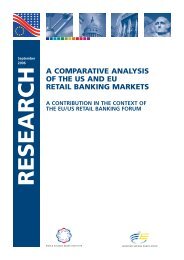Corporate Governance and Access to Finance - ESBG
Corporate Governance and Access to Finance - ESBG
Corporate Governance and Access to Finance - ESBG
Create successful ePaper yourself
Turn your PDF publications into a flip-book with our unique Google optimized e-Paper software.
Figure A.1. Structure of agents' relationships in the creditinstitutions activities with stakeholdersDeposi<strong>to</strong>rsBorrowersFinancial servicescontractsDepositinsurance,other facilitiesSupervision <strong>and</strong>regula<strong>to</strong>ry agencyMotivation <strong>and</strong>incentivemanagementcontractsCredit institutionsmanagersRisky investmentdecisionsStakeholders- Founders- Public Administration- Deposi<strong>to</strong>rs- Local communitiesShareholders- OwnersFigure A. 1 shows a simplified scheme of the relationships between themain players in the banking institution activities. Any of the arrows reflectrelationships between them as managers, deposi<strong>to</strong>rs, borrowers, owners,regula<strong>to</strong>ry bodies <strong>and</strong> other stakeholders, which should be based ontrust, which can be reinforced through a set of <strong>Corporate</strong> <strong>Governance</strong>practices. The financial services contracts should be provided with security,avoiding fraud, ambiguity <strong>and</strong> litigation. A system with coverage by depositinsurance schemes <strong>and</strong> the control <strong>and</strong> supervision by credible regula<strong>to</strong>rybodies help achieving this security. Efficient managers running creditinstitutions would reduce transaction costs, allowing for the compatibilitybetween the viability of the institution, appropriate remuneration ofsavings <strong>and</strong> affordable costs of the loans, <strong>and</strong> facilitating proximity <strong>to</strong>the cus<strong>to</strong>mers.99
















